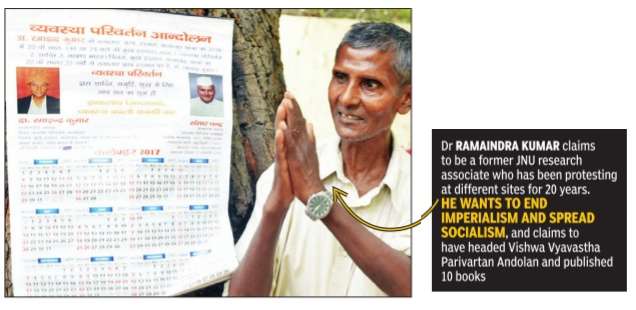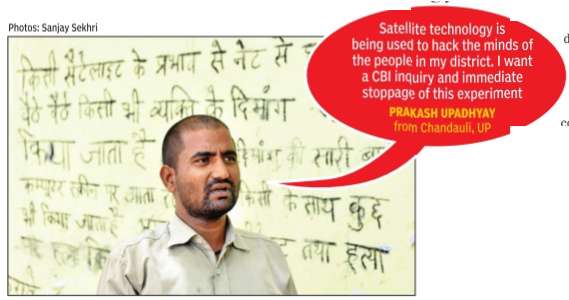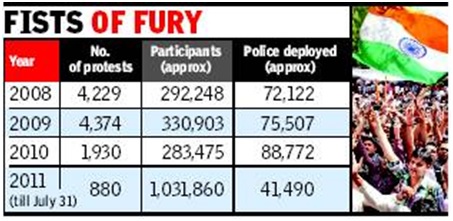Delhi: Political protests
(→Jantar Mantar) |
|||
| Line 13: | Line 13: | ||
=Jantar Mantar= | =Jantar Mantar= | ||
| − | + | ==Its status as a protest venue in 2011== | |
Neeraj Chauhan TNN | Neeraj Chauhan TNN | ||
Revision as of 16:12, 7 October 2017
This is a collection of articles archived for the excellence of their content. |
Contents |
Jantar Mantar
Its status as a protest venue in 2011
Neeraj Chauhan TNN
The Times of India, Aug 8, 2011
Delhi Police claims there could be law and order problems if it allows the Gandhian crusader against corruption to sit on an indefinite hunger strike at Jantar Mantar along with thousands of his followers for more than a day or two.
But according to Delhi Police itself, on an average, over 2,000 demonstrations, dharnas and rallies involving three to five lakh people are held here every year and over 80,000 security personnel get deployed to manage them. Very few of these protests turn violent, most go on silently for months, some even for years.
The rebirth of this astronomical observatory of the 18th century as the breeding ground of protests occurred in 1993 when the Narasimha Rao government banned such activities at the Boat Club. Since then, it has been witness to every major and minor protest in the capital, including the AIIMS agitation, farmers’ protest and Hazare’s first phase of campaign against corruption.
On an average, 10 to 15 rallies/protests take place daily and police arrangements are always in place. The number of personnel varies though, depending on the need of the situation. Delhi Police says that till July 31 this year, 880 protests have taken place at Jantar Mantar and the nearby areas.
While 1,031,860 people have participated in them, 41,940 officers have been deployed for these protests marked under different categories — demonstrations (570), rallies (37), dharnas (216) and strikes/ hunger strikes (57). Officials say this year’s figure has been the highest in the past few years because of Hazare’s previous campaign.
People from every corner of the country could be seen here through out the year, raising different issues. “I have been posted here at Parliament Street police station for the past two-and-a-half years. I everyday see people coming from different places. Somebody has an individual problem of his department not giving him his dues, someone wants to root out corruption from the country or someone else may be fighting cruelty against animals. Some of them stay here for several months,” said a cop.
2017: National Green Tribunal bans protests at Jantar Mantar
Manash Gohain | Why Jantar Mantar may be irreplaceable |Oct 07 2017 : The Times of India (Delhi)
BJP [the national ruling party] said that NGT is a statutory body and is empowered to take decisions on its own. Vijender Gupta, leader of opposition in Delhi assembly , said, “People residing near Jantar Mantar have been fighting for the past 10 years to shift the protest venue. Noise pollution can't be overlooked and NGT is empowered to take decisions related to environment.“
The Times of India’s View
The National Green Tribunal's order asking the government to stop all protests at Jantar Mantar amounts to a reduction of the space for democratic dissent available. The NGT might feel that an alternate protest site in Ramlila Maidan would serve the purpose just as well, but the further away protest sites are from those whose eyes and ears they want to catch -in this case Parliament-the less meaningful they become. The right to protest is absolutely crucial to democracy and reducing that to a mere token does not serve the polity well. We hope this order will be reconsidered.
The issues that people protest about
1
Paras Singh, From basic to bizarre at Delhi's protest bazaar, May 12, 2017: The Times of India




Jantar Mantar has been the city's default agitation venue, with people sitting on stir for months on end for issues ranging from military pensions to jailed godmen
The national flag in his tight grip, 32-yr-old Abdul Gaffur Toofani scoffs at the 42 degree Celsius heat. His passion is hotter: he wants terrorism disassociated from Islam. It is a legitimate demand, but did he have to come all the way from Araria in Bihar to this leafy stretch in Delhi to say so?
“Yes, because here we get heard,“ he responds unequivocally.
Indeed, it is at this site, called “Mini India“ by historian Ramachandra Guha, that people from across the country gather hoping to be heard. Abutting the medieval astronomical laboratory of Jantar Mantar, scoffers would dismiss the disparate demands being made as pies in the skies. Indeed, it would appear so when there are people like Prakash Upadhyay, 30, from Chandauli, protesting against “satellite technology being used to hack people's minds in my district“ and Dattatreya Mohan, 47, demanding Rs 4,300 crore plus interest that the government “owes him after the British government illegally occupied my 1.7-acre land in Sangli in 1881 for railway use“.
But as David Raj, 27, who wants the 7,000 liquor shops in Delhi shut down, pointed out, “This is a perfect place to get the government's attention because of its nearness to Parliament.“ No wonder so many have lingered on trying to catch the government's attention. Eleven ex-servicemen recorded the 696th day of their relay hunger strike for one-rank-one-pension on Wednesday . The followers of Asaram Bapu and Rampal have spent 1,354 and 601 days, respectively, at Jantar Mantar, trying to persuade the authorities to free their jailed spiritual gurus.
On Tuesday, the National Green Tribunal asked Delhi government why it had not explored an alternative site for the disgruntled democrats to exercise their right to protest. Justice Swatanter Kumar, NGT chairperson, wondered why Delhi's version of Speakers' Corner in Lon don's Hyde P a r k could not be located at more convenient places such as Ramlila Maidan. Indeed, the 200-metre span of the neem-tree-lined Jantar Mantar Road is overstretched.Parliament Street police station receives 24,000 requests for permission to hold protests every year. The thousands congregating there -“Some people have been living here for years; we removed around 40 tents of such protestors in the past few weeks,“ said the area SHO -has only created its own economy, but has placed a big strain on civic amenities. After the infamous capture by farmers of the original protest spot at Boat Club near India Gate in 1988, the government shifted the theatre of protests to Jantar Mantar.Since then, eight small eateries, a dozen tea services and even a couple of barbers have set up businesses to meet the needs of discontented Indians.
Hygiene, however, is a barely addressed necessity. A grossly overused public restroom and a few here-today-gone-tomorrow mobile toilets force most to do the best they can when nature calls. Bangla Sahib Gurdwara in the vicinity is generous with both food and toilets, but it cannot cater to the teeming crowds.
“There is filth all around,“ grumbled Varun Seth, whose bungalow is located on the stretch.Besides the disgust of open defecation, the residents have to suffer constant cacophony and jammed lanes. Seth is one of those who petitioned the National Green Tribunal to get the protestors moved to another location. The Dhawandeep Society RWA too has approached Delhi high court on the matter.
But to the myriad protestors these don't matter. Ask them if anyone has ever heard their slogans, and there are affirmative nods.“You did, didn't you?“ quipped one of them. And that is inspiration enough for the genuinely disaffected as well as the mavericks at Jantar Mantar as they bid to challenge the Establishment.
2
Manash Gohain | Why Jantar Mantar may be irreplaceable |Oct 07 2017 : The Times of India (Delhi)
Saket Bahuguna, national media convener of ABVP , said, “Jantar Mantar holds many memories for people, right from Nirbhaya to UPSC and UGC protests.“
The co-founder of HAQ: Centre for Child Rights, Enakshi Ganguly Thukral, recollected the time protesters were shifted out of India Gate and Boat Club to Jantar Mantar, Thukral said, “We felt like monkeys on display when we were shifted to Jantar Mantar. But it is still close to Parliament. Shifting us to Ramlila Maidan feels like the powers that be will determine how and where we will protest and how we will be treated.“
MARRY ME, MR PM
This 45-year-old from Jaipur is on an indefinite strike at Jantar Mantar since the first week of September for a bizarre reason -she wants to marry Prime Minister Narendra Modi. Om Shanti Sharma was married to a goldsmith 27 years ago, but he deserted her within a year. She has a daughter with her estranged husband.“I read in newspapers that the PM is transforming India. As his wife doesn't stay with him, he needs somebody to take care of him,“ Sharma said.Sharma wanted to sit-in at Lok Kalyan Marg, but cops told her to go to Jantar Mantar. She has written several marriage proposals to Modi and is even willing to divorce her husband.“I'm ready to face batons, but won't leave this place,“ she added.
SHOE-ING AWAY CORRUPTION
Akhil Bhartiya Joota Mar Andolan's architect Manchhindra Nath thinks that beating the corrupt with shoes is the only way. “I have helped over 100 people get justice. I also go to several states to follow up on complaints,“ said Nath, who occupies a 100 square feet area at Jantar Mantar. On protest for the past 11 years, he has been seeking justice by sending letters to the President, PM, CM, DM and other authorities. Nath has many disciples who sleep on pavements and eat at langars throughout the year. “The government wants to remove us from Jantar Mantar to weaken the power of our voice. We'd rather die than go elsewhere,“ he said.
ALIVE AND KICKING
He's the most famous protester at Jantar Mantar. Santosh Kumar Singh (37) was declared `dead' in 2003. He has been protesting for the last five years. He had even filed the nomination for presidential polls in 2012.In 2003, Singh married a Dalit woman in Maharashtra while working as cook for Bollywood actor Nana Patekar. Miffed at his act, this upper caste man's cousins bribed the land and revenue officials in Varanasi and got his name removed from records claiming that he died in the 2003 Mumbai blasts to usurp his 13.5 acres. Singh came to know about his `death' when his relatives conducted his last rites. He then started an agitation for getting back his land from his cousins.
HIGH ON LIQUOR BAN
His ex-serviceman father is into construction, his sister is married in an MLA family, but 29-year-old David Raj from Tamil Nadu is on an indefinite dharna demanding countrywide liquor ban. “When people die due to dengue, a huge hue and cry is made. But why doesn't anyone speak up about liquor, the silent killer that claims 18 lakh lives every year?“ asks Raj. He has organised several hunger strikes and protests in Tamil Nadu and once even climbed a telephone tower. He journeyed to Jantar Mantar 159 days ago after “torture“ by cops. “I will go to jail, but won't leave this protest site,“ Raj said.
